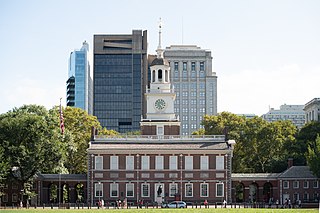
A National Historic Landmark (NHL) is a building, district, object, site, or structure that is officially recognized by the United States government for its outstanding historical significance. Only some 2,500, or roughly three percent, of over 90,000 places listed on the country's National Register of Historic Places are recognized as National Historic Landmarks.
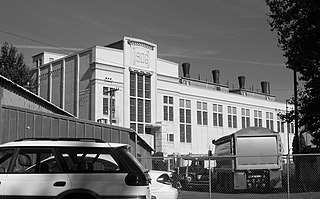
The Georgetown Steam Plant, located in the Georgetown neighborhood of Seattle, Washington, was constructed in 1906 for the Seattle Electric Company to provide power for Seattle, notably for streetcars.

The American Bank Note Company Building is a five-story building at 70 Broad Street in the Financial District of Manhattan in New York City. The building was designed by architects Kirby, Petit & Green in the neo-classical style, and contains almost 20,000 square feet (1,900 m2) of space, with offices and residences on the upper floors. The exterior consists of a main facade on Broad Street with two columns, as well as side facades with pilasters on Beaver and Marketfield Streets.

There are 75 properties listed on the National Register of Historic Places in Albany, New York, United States. Six are additionally designated as National Historic Landmarks (NHLs), the most of any city in the state after New York City. Another 14 are historic districts, for which 20 of the listings are also contributing properties. Two properties, both buildings, that had been listed in the past but have since been demolished have been delisted; one building that is also no longer extant remains listed.

The Stevenson Dam Hydroelectric Plant is a hydroelectric power plant located on the Housatonic River at the boundary between the towns of Monroe and Oxford, Connecticut. The Connecticut Light and Power Company began construction in 1917 and FirstLight Power has since gained ownership. It was listed on the National Register of Historic Places in 2000 and is considered to have high hazard potential by the National Inventory of Dams. The site includes three contributing structures: the Stevenson Dam, the Stevenson Dam Bridge, and the Stevenson Powerhouse.

The C. R. Joy House, also known as The Grande Anne Bed & Breakfast, was a historic building located in Keokuk, Iowa, United States. It was destroyed by fire in July 2018. It was individually listed on the National Register of Historic Places in 1997. In 2002 it was included as a contributing property in The Park Place-Grand Avenue Residential District.

Wheeling Warehouse Historic District is a national historic district located at Wheeling, Ohio County, West Virginia. The district includes 20 contributing buildings and 11 contributing structures. They are warehouses and commercial style buildings and structures between Main Street and the Ohio River. All of the buildings date to the late-19th and early-20th century. The warehouses are mostly two- and three-story masonry buildings. The two-story commercial buildings have storefronts on the first floor and residential units above. Notable buildings and structures include the Pump Store (1933), Wheeling Stamping Plant (1932), Allied Plate Glass, Warwick China, Boury Warehouse, Ott-Heiskell Company, Edward Wagner Wholesale Grocers building (1915), the Moderne style former Greyhound Bus Station, and Main Street Bridge (1891).
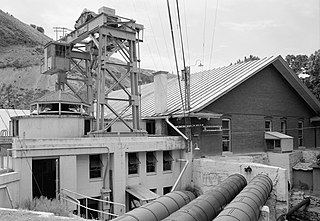
The Olmsted Power Station is a historic building located in Orem, Utah, United States. It is listed on the National Register of Historic Places. The hydropower plant was dedicated on April 12, 1904 and decommissioned on September 21, 2015. The plant will become a museum after a seismic refit of the building.

Elizabeth City Water Plant is a historic municipal water plant located at Elizabeth City, Pasquotank County, North Carolina. The complex includes the contributing Elizabeth City Water Plant Building, Coagulation Basin (1926), Raw Water Pump House, the Circular Finished Water Reservoir (1926), and the Raw Water Reservoir. The Elizabeth City Water Plant Building is a Mission Revival style brick building sheathed in stucco and built in 1926. It consists of a projecting three-bay three-story central pavilion flanked on each side by identical two-story blocks. It is topped by a broad hipped roof covered by green clay tiles.

The Seaholm Power Plant is a historic former power station located on the north shore of Lady Bird Lake in Downtown Austin, Texas. Opened in 1951, it is listed on the National Register of Historic Places and designated as a Recorded Texas Historic Landmark. The power plant ceased operation in 1996, and the facility and site were later redeveloped into a mixed-use district.

Renwick Generating Plant, also known as the Municipal Steam Light Plant, is a historical industrial facility located in Renwick, Iowa, United States. G.L. Long was an engineer who was contracted in 1914 to design a steam-powered electrical light plant. It first distributed energy on March 14, 1915, at 6:00 p.m. The steam engines were replaced by a 75-horsepower, two-cylinder, semi-diesel engine and generating equipment manufactured by Fairbanks-Morse in 1922. A 125-horsepower diesel engine manufactured by Worthington Pump and Machinery Corporation was added in 1936. At that time the plant started to supply power to a newly formed rural electric cooperative that was funded by the Rural Electrification Act of 1936. A Faribanks-Morse 300-horsepower, four-cylinder diesel was added in 1939, and the 75-horsepower and 40-horsepower engines were replaced in 1942 by another 300-horsepower diesel. An addition was added onto the north side of the building the same year. It housed the local fire department and city hall. The facility was listed as a historic district on the National Register of Historic Places in 1995.
Greenfield Public Square Historic District is a nationally recognized historic district located in Greenfield, Iowa, United States. It was listed on the National Register of Historic Places in 2014. At the time of its nomination the district consisted of 52 resources, including 42 contributing buildings, one contributing site, six noncontributing buildings, and three noncontributing objects. The historic district covers part of the city's central business district in the center of the original town plat. There is a significant number of one- and two-story, brick, commercial buildings, as well as a few three-story structures. The Commercial Italianate style is dominant. While the vast majority of the buildings are commercial buildings, there are four government buildings in the district: the Adair County Courthouse (1892), public library (1916), city hall (1930), and the municipal light plant (1940). Besides the courthouse, the other buildings that are individually listed on the National Register include Warren Opera House Block and Hetherington Block (1896), Adair County Democrat-Adair County Free Press Building (1903), and the Hotel Greenfield (1920).

The Kirk was a historic building located in Mason City, Iowa, United States. Completed in 1903, this was the city's first luxury apartment building. Horace P Kirk, who owned and managed the building, was a Mason City businessman, photographer, and civic leader. He built two other buildings here and to the north that were destroyed in a fire in 1902. This building was built on the site of Kirkland Flats, and parts of its stone foundation and north wall may be from the H.P. Kirk wholesale building that had been built in 1892. Originally The Kirk supplied heat, light, and water for the apartments with its own steam generating plant. It has subsequently acquired city utilities. The building features an eclectic design that is organized into horizontal and vertical elements. The horizontal is realized in wide brick bands on the floors. The vertical is realized in the copper-clad oriel windows that tie the second and third floors to the cornice. The building was individually listed on the National Register of Historic Places in 1982, and as a contributing property in the Mason City Downtown Historic District in 2005.
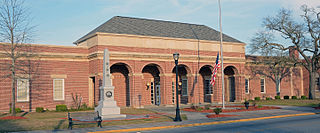
The Emanuel County Courthouse in Swainsboro, Georgia serves Emanuel County. The current building is the county's eighth courthouse.

The James Coleman House was built in Swainsboro, Georgia during 1900–1904. It was listed on the National Register of Historic Places in 1992. In 2017, it was a bed and breakfast inn, the Coleman House Inn.
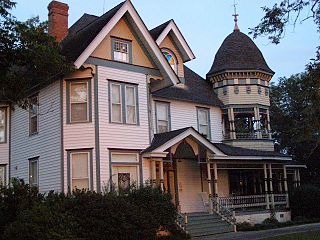
The James W. Coleman House was built in Moultrie in Colquitt County, Georgia, in 1903 and listed on the National Register of Historic Places in 1983.

The Albert Neal Durden House, also known as the Durden-Brinson-Brewer House, is located in Emanuel County, Georgia near Twin City, Georgia. It was listed on the National Register of Historic Places with three contributing buildings, a contributing structure, and three non-contributing buildings on 162 acres (66 ha) in 1990.
Dennis & Dennis was an architectural partnership in the U.S. state of Georgia which was Georgia's oldest architectural firm. It designed numerous commercial, institutional and residential buildings in Macon and other Georgia communities.

The Glendive Heat, Light and Power Company Power Plant on Clough St. in Glendive, Montana was built in 1914. It was listed on the National Register of Historic Places in 1988. The listing included a contributing building and two contributing structures.

Fernbrook Farms is a 230-acre (93 ha) working farm located along County Route 545 in Chesterfield Township in Burlington County, New Jersey. Originally an 18th-century farm, it was briefly a stock breeding farm, known as the New Warlaby Stock Farm, in the 19th century. It now includes an inn, plant nursery, environmental education center, and community-supported agriculture. It was added to the National Register of Historic Places on July 7, 2022, for its significance in architecture and landscape architecture.




















